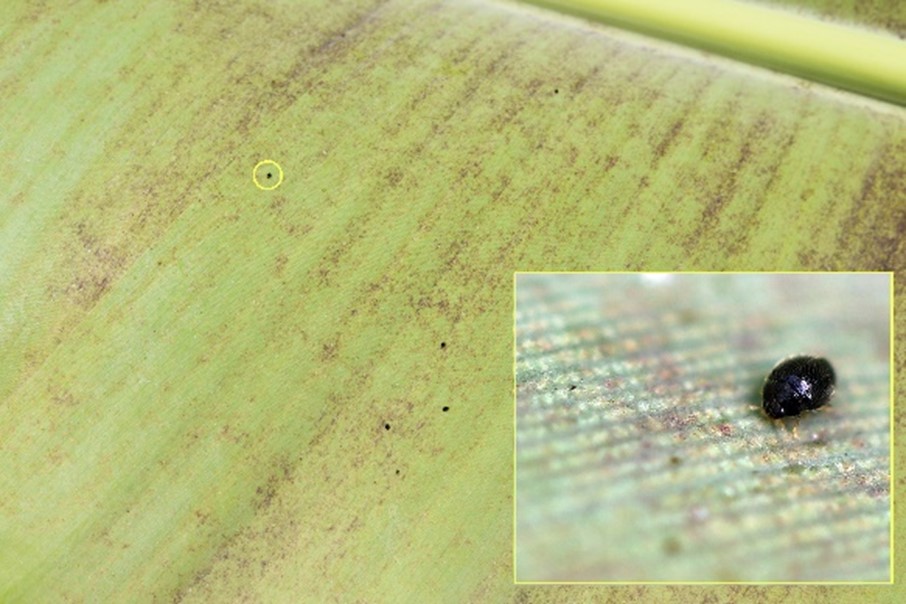Encouraging spider mite predators
Promoting predatory insects to manage mite levels is best done by limiting the use of harmful chemicals, such as broad-spectrum insecticides and miticides, which affect beneficial predatory mites and Stethorus.
Stethorus, the shiny black pinhead-sized lady beetles, are naturally occurring mite predators. They tend to increase in number when spider mite populations are high, as they utilise spider mites as a food source to survive. However, there may be a delay in their population growth due to the initial lack of spider mites.

Predatory mites such as Neoseiulus californicus (Californicus) and Phytoseilus persimilis (Persimilis) can also be purchased for release in your blocks from biological agent suppliers. It has been found that Persimilis may be the more efficient predator in south-eastern Queensland and northern NSW, as it utilises the webbing of the two-spotted spider mite, to locate its prey. While, in Far North Queensland, it’s advised to use the predatory mite Califonicus due to its suitability to the climatic conditions and its effectiveness against the predominant predatory mite, the banana spider mite.
Click here to read more about predators and other beneficial insects
Monitoring mite populations
Mites have a short life cycle which can be as short as 7-10 days during hot-dry conditions and as long as 4 weeks. Over summer months, weekly monitoring is preferable, however, fortnightly is sufficient during cooler, wet conditions. To monitor for the presence of mites, check plants for overall mite damage. The following categories can be used as a guide for the assessment of damage on the underside of leaves.
1 = Low
A few mite colonies on leaves and minor (more than one or two) localised bronzing on the under surface of leaves

2 = Moderate
Mite colonies are scattered but numerous; bronzing is clearly evident on leaves (patchy but starting to coalesce) but the damage is contained within the interveinal areas.

3 = High
Mite colonies coalescing and bronzing damage over most of the leaves.

Applying miticides may be unnecessary if you have low to moderate levels (categories 1 or 2) of spider mite damage and healthy predator populations. To understand mite populations, a X10 magnifying glass is needed to observe all stages of mites (including eggs, nymphs and adults). A healthy predator population may look like finding predatory eggs and nymphs near the mite colonies. This may include finding small black Stethorus beetles. Stethorus are found mainly on the underside of leaves, with their pupae found close to the mid-rib. The presence or absence of mite predators can help you determine the best management strategy moving forward.

If healthy predator populations are detected then your consultant may advise continued weekly monitoring. You may also consider boosting the number of natural predators by releasing the predatory mite Californicus as a hot-spot treatment if only certain parts of the paddock are having mite flares.

In addition to an overall damage assessment, it is also important to take note of the youngest leaf the mites are present on. In general, mites will move up the plant to the younger leaves, particularly as the population grows. By monitoring the movement of mites, decisions about the implementation of control practices to reduce or prevent the severity of irreversible damage to new leaves can be made. In general, the greater the number of mites and the younger the leaves they attack, the more severe the infestation.
It’s important to monitor regularly as spider mite populations can increase rapidly under favourable weather conditions (hot and dry). Therefore, always consider weather conditions before making management decisions. Rain and wet weather will help to keep spider mite populations down. If population levels are high, one rain event may not be enough to reduce spider mite populations sufficiently.
If you have high levels of damage (category 3) and spider mites are present on newly emerged leaves then a miticide treatment will be required to gain control of the population. Click here to view the chemical information below and talk to your consultant for specifics.
For more information contact
The Better Bananas team
Department of Agriculture and Fisheries
South Johnstone
Email betterbananas@daf.qld.gov.au
This information is adapted from: Pinese, B., Piper. R 1994, Bananas insect and mite management, Department of Primary Industries, Queensland
This information has been prepared as part of the National Banana Development and Extension Program (BA19004) which is funded by Hort Innovation, using the banana industry research and development levies and contributions from the Australian Government. Hort Innovation is the grower-owned, not-for-profit research and development corporation for Australian horticulture. The Queensland Government has also co-funded the project through the Department of Agriculture and Fisheries.


